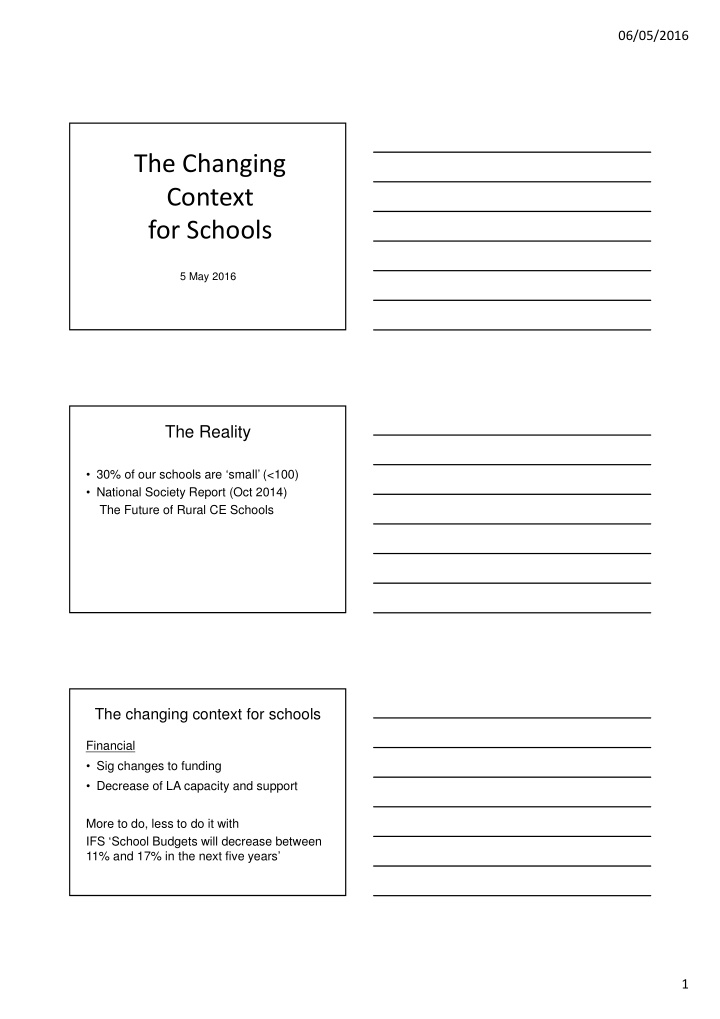



06/05/2016 The Changing Context for Schools 5 May 2016 The Reality • 30% of our schools are ‘small’ (<100) • National Society Report (Oct 2014) The Future of Rural CE Schools The changing context for schools Financial • Sig changes to funding • Decrease of LA capacity and support More to do, less to do it with IFS ‘School Budgets will decrease between 11% and 17% in the next five years’ 1
06/05/2016 The changing context for schools Leadership / teacher capacity • 2014 –over 50,000 left the profession, est 40% were HTs • ATL figures 40% of teachers leave within the first 12months • 62 HT appointments (21%) in the last 2 years The changing context for schools Political and Structural changes • ‘Autonomy’ for schools • Academy Agenda • New providers • School effectiveness challenges The changing context for schools • Financial • Leadership retention • Structural changes • The Academy Agenda 2
06/05/2016 The changing context for schools The Academy agenda • Lack of LA funding and support for schools • School ‘improvement’? • Need for ‘school to school’ support • Pressure on ‘non-viable’ units • ‘Educational Excellence Everywhere’ New schools • Sig increase in population • Global business providers of Education • ‘Church’ led bids less successful The changing context • Groupings of schools have become essential especially for smaller schools • Models of MAT • ODST MAT • New and free school bids 3
06/05/2016 So far … in brief … ODBE • Falling school rolls in rural areas • Funding issues • Leadership recruitment issues • Academy agenda • Potential closures What are we doing? • Facing the future • Daring to be different • Structural Collaboration The changing context Facing the future • Hold up the mirror • Reality check • Talking to Governing Bodies • Talking to Local Authorities • Talking to local Churches /PCCs • NS report appendix –Self Review Questionnaire -essential 4
06/05/2016 The changing context Dare to be different • The past is gone, encouragement to think differently • Consider shared /exec leadership • Sharing of resources • Procurement options • Identifying and training EHTs of Church schools The changing context for small(er) schools Structural Collaboration • No longer optional • Academy Conversion Policy • Brokering the right partnerships • Collaborations /Federations /Amalgamations • Multi Academy Trusts The changing context • Think NOW (GB, staff etc) • What do we want /who do we want it with? (like-mindedness) • Speak to us • Self evaluation questionnaire 5
06/05/2016 Models for Governance There are three main governance models suggested by the DfE for chains of academies: • Informal Collaboration • Umbrella Trust • Multi-Academy Trust What will becoming an academy mean? • More money? • New buildings? • New teachers? • Changed admissions? • Different catchment? • Improved standards? • Extra costs? Oxford Diocesan School Trust � ODST is a multi academy trust (MAT) � It currently has 17 schools either established or in the process of converting � All the academies in ODST are governed by a single board of directors. � Local governing bodies in each of its academies, have delegated powers and functions. � The Directors of ODST are accountable to the Secretary of State for the performance of the academies within the trust � It provides bespoke services to its schools 6
06/05/2016 Multi-Academy Trust (MAT) Members Board of Directors / Trustees Scheme of Delegation GB GB GB GB GB School School School School School 1 2 3 4 5 … Due Diligence; Looking at ourselves: What can we offer? What do we need? Where next? Establish a GB working group Hold conversations – with whom? Key Questions; Ethos, Finance, Governance … and … Do not rush unnecessarily… Any final questions? 7
Recommend
More recommend